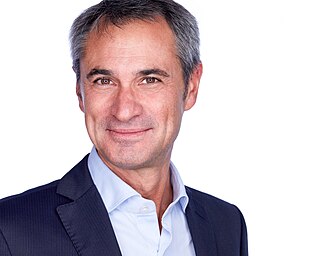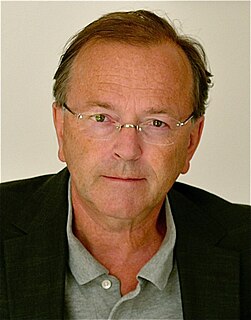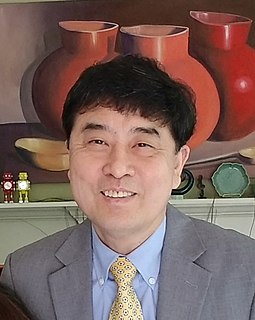Related Research Articles

Evolutionary developmental biology is a field of biological research that compares the developmental processes of different organisms to infer the ancestral relationships between them and how developmental processes evolved.

In computer science, evolutionary computation is a family of algorithms for global optimization inspired by biological evolution, and the subfield of artificial intelligence and soft computing studying these algorithms. In technical terms, they are a family of population-based trial and error problem solvers with a metaheuristic or stochastic optimization character.
Bio-inspired computing, short for biologically inspired computing, is a field of study which seeks to solve computer science problems using models of biology. It relates to connectionism, social behavior, and emergence. Within computer science, bio-inspired computing relates to artificial intelligence and machine learning. Bio-inspired computing is a major subset of natural computation.
Neuromorphic engineering, also known as neuromorphic computing, is a concept developed by Carver Mead, in the late 1980s, describing the use of very-large-scale integration (VLSI) systems containing electronic analog circuits to mimic neuro-biological architectures present in the nervous system. In recent times, the term neuromorphic has been used to describe analog, digital, mixed-mode analog/digital VLSI, and software systems that implement models of neural systems. The implementation of neuromorphic computing on the hardware level can be realized by oxide-based memristors, spintronic memories, threshold switches, and transistors.

Dario Floreano is director of the Laboratory of Intelligent System (LIS) at the École Polytechnique Fédérale de Lausanne in Switzerland as well as the Swiss National Centre of Competence in Research (NCCR) Robotics.
Developmental robotics (DevRob), sometimes called epigenetic robotics, is a scientific field which aims at studying the developmental mechanisms, architectures and constraints that allow lifelong and open-ended learning of new skills and new knowledge in embodied machines. As in human children, learning is expected to be cumulative and of progressively increasing complexity, and to result from self-exploration of the world in combination with social interaction. The typical methodological approach consists in starting from theories of human and animal development elaborated in fields such as developmental psychology, neuroscience, developmental and evolutionary biology, and linguistics, then to formalize and implement them in robots, sometimes exploring extensions or variants of them. The experimentation of those models in robots allows researchers to confront them with reality, and as a consequence, developmental robotics also provides feedback and novel hypotheses on theories of human and animal development.
The expression computational intelligence (CI) usually refers to the ability of a computer to learn a specific task from data or experimental observation. Even though it is commonly considered a synonym of soft computing, there is still no commonly accepted definition of computational intelligence.
In cognitive science, a cognitive architecture refers to both a theory about the structure of the human mind and to a computational instantiation of such a theory used in the fields of artificial intelligence (AI) and computational cognitive science. One of the main goals of a cognitive architecture is to summarize the various results of cognitive psychology in a comprehensive computer model. However, the results need to be formalized so far as they can be the basis of a computer program. The formalized models can be used to further refine a comprehensive theory of cognition, and more immediately, as a commercially usable model. Successful cognitive architectures include ACT-R and SOAR.
Cognitive robotics is a subfield of robotics concerned with endowing a robot with intelligent behavior by providing it with a processing architecture that will allow it to learn and reason about how to behave in response to complex goals in a complex world. Cognitive robotics may be considered the engineering branch of embodied cognitive science and embodied embedded cognition.
Robotics is the branch of technology that deals with the design, construction, operation, structural disposition, manufacture and application of robots. Robotics is related to the sciences of electronics, engineering, mechanics, and software. The word "robot" was introduced to the public by Czech writer Karel Čapek in his play R.U.R., published in 1920. The term "robotics" was coined by Isaac Asimov in his 1941 science fiction short-story "Liar!"

In the developmental biology of the early twentieth century, a morphogenetic field is a group of cells able to respond to discrete, localized biochemical signals leading to the development of specific morphological structures or organs. The spatial and temporal extents of the embryonic field are dynamic, and within the field is a collection of interacting cells out of which a particular organ is formed. As a group, the cells within a given morphogenetic field are constrained: thus, cells in a limb field will become a limb tissue, those in a cardiac field will become heart tissue. However, specific cellular programming of individual cells in a field is flexible: an individual cell in a cardiac field can be redirected via cell-to-cell signaling to replace specific damaged or missing cells. Imaginal discs in insect larvae are examples of morphogenetic fields.

The BioWall is a bio-inspired computing surface made of several thousand electronic modules which can be seen as artificial molecules. Each of these modules contains a programmable electronic circuit, a touch sensor and a display composed of 64 LEDs. As a result, each module enables the visitor to communicate with the surface by touching it with his finger, calculates its new status and indicates it immediately on a coloured display.

Gerd B. Müller is an Austrian biologist who is professor at the University of Vienna where he heads the Department of Theoretical Biology in the Center for Organismal Systems Biology. His research interests focus on vertebrate limb development, evolutionary novelties, evo-devo theory, and the Extended Evolutionary Synthesis. He is also concerned with the development of 3D based imaging tools in developmental biology.
Informatics is the study of computational systems, especially those for data storage and retrieval. According to ACM Europe andInformatics Europe, informatics is synonymous with computer science and computing as a profession, in which the central notion is transformation of information. In other countries, the term "informatics" is used with a different meaning in the context of library science.
Morphogenetic robotics generally refers to the methodologies that address challenges in robotics inspired by biological morphogenesis.
Susan Oyama is a psychologist and philosopher of science, currently professor emerita at the John Jay College and CUNY Graduate Center in New York City.
Brian Keith Hall is the George S. Campbell Professor of Biology and University Research Professor Emeritus at Dalhousie University in Halifax, Nova Scotia. Professor Hall has researched and extensively written on bone and cartilage formation in developing vertebrate embryos. He is an active participant in the evolutionary developmental biology (EVO-DEVO) debate on the nature and mechanisms of animal body plan formation. Professor Hall has proposed that the neural crest tissue of vertebrates may be viewed as a fourth embryonic germ layer. As such, the neural crest - in Hall's view - plays a role equivalent to that of the endoderm, mesoderm, and ectoderm of bilaterian development and is a definitive feature of vertebrates. As such, vertebrates are the only quadroblastic, rather than triploblastic bilaterian animals. In vertebrates the neural crest serves to integrate the somatic division and visceral division together via a wide range novel vertebrate tissues.

The extended evolutionary synthesis consists of a set of theoretical concepts argued to be more comprehensive than the earlier modern synthesis of evolutionary biology that took place between 1918 and 1942. The extended evolutionary synthesis was called for in the 1950s by C. H. Waddington, argued for on the basis of punctuated equilibrium by Stephen Jay Gould and Niles Eldredge in the 1980s, and was reconceptualized in 2007 by Massimo Pigliucci and Gerd B. Müller.
Multi-task optimization is a paradigm in the optimization literature that focuses on solving multiple self-contained tasks simultaneously. The paradigm has been inspired by the well-established concepts of transfer learning and multi-task learning in predictive analytics.

Chan-Jin Chung (정찬진) or popularly known as "CJ" Chung is a full professor of Computer Science at Lawrence Technological University(LTU) in Michigan, USA. He founded an international autonomous robotics competition called Robofest in the 1999–2000 academic year as well as numerous educational programs for youth by integrating STEM, arts, autonomous robotics, and computer science. He also served as the founding USA National Organizer of World Robot Olympiad (WRO) in 2014 and 2015. He also started the WISER conference in 2014. His research areas include evolutionary computation, cultural algorithms, intelligent systems & autonomous mobile robotics, software engineering, machine learning & deep learning, computer science education, and educational robotics.
References
- ↑ Y. Jin and Y. Meng, "Morphogenetic robotics: A new emerging field in developmental robotics. IEEE Transactions on Systems, Man, and Cybernetics, Part C: Reviews and Applications, 41(2):145-160, 2011
- ↑ Y. Jin and Y. Meng. "Evolutionary Developmental Robotics: The Next Step to Go?" IEEE CIS AMD Newsletter, 8(1):13-14, 2011
- ↑ H. Lipson, Evolutionary robotics and open-ended design automation.
- ↑ J. Kodjabachian and J.-A. Meyer, Development, learning and evolution in animats. From Perception to Action, IEEE Press, 1994
- ↑ D. Floreano, and J. Urzelai. Neural morphogenesis, synaptic plasticity and evolution. Theory in Biosciences, 120(3-4):225-240, 2001
- ↑ J. Kodjabachian and J.-A. Meyer. Evolution and development of neural controllers for locomotion, gradient-following and obstacle avoidance in artificial insects. IEEE Trans. on Neural Networks, 9(5):796-812, 1998
- ↑ M. Sipper et al. A phylogenetic, ontogenetic, and epigenetic view of bio-inspired hardware systems. IEEE Trans. on Evolutionary Computation. 1(1):83-97, 1997
- ↑ H. Guo, Y. Meng, and Y. Jin. A cellular mechanism for multi-robot construction via evolutionary multi-objective optimization of a gene regulatory network. BioSystems, 98(3):193-203, 2009
- ↑ C. Teuscher, D. Mange, A. Stauffer, and G. Tempesti. Bio-inspired computing tissues: Towards machines that evolve, grow, and learn. IPCAT'2001, April 2001